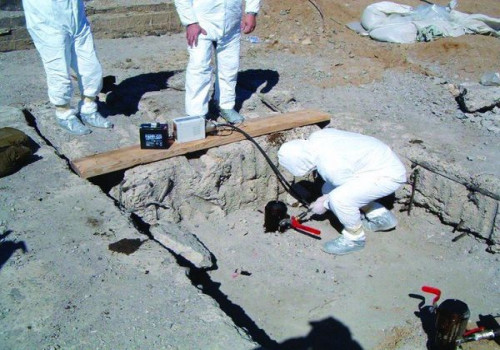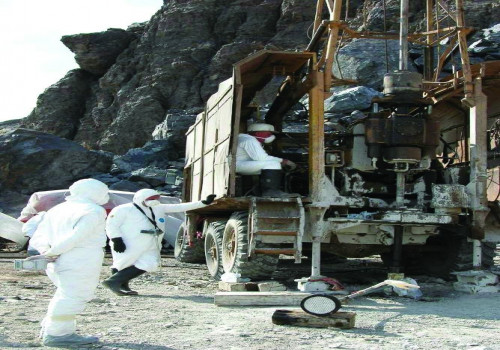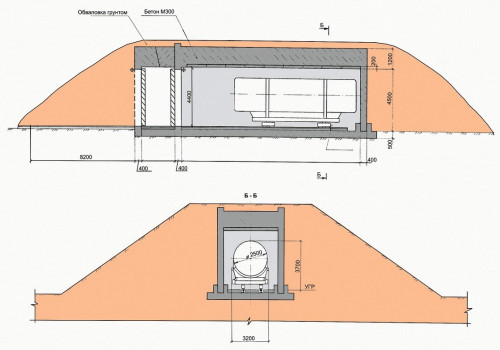Nuclear Tests Consequences Elimination. “Kolba” Containers Preservation
09 May 2022



30 projects to the 30th anniversary of NNC RK
Project No.6. 1997–2007. Nuclear Tests Consequences Elimination. “Kolba” Containers Preservation
Within the period from 2005 to 2012, specialists of NNC RK, Rosatom (Russian Federation) and US DoD DTRA perform the operations at 44 objects of the former STS, as follows:
- Removal and transportation of radioactive specialized technological equipment from two objects of the Degelen rock massif;
- Creation of additional concrete and reinforced concrete protective barriers at forty two objects of Degelen rock massif, filling of inner boxes cavities containing residues of nuclear activity (RONA) at these objects with binding material – sand cement and magnetite solutions.
The work began with the agreement of a sufficiently large number of objects that meet selected and agreed criteria for assessing the risks of "proliferation". For each facility, a quantitative assessment of the risk value was obtained. As a result, all the objects were divided into four categories by hazard. The Russian party proposed to consider the possibility of constructing the additional protective barriers excluding the access to RONA without use of industrial methods at a number of facilities corresponding to hazard levels from 4 to 2 inclusively. The fourth level represents maximal hazard. Three objects corresponded to this level were assigned with symbols like “X”, “Y”, “Z”.
A fundamentally new aspect in these operations was the consent of Kazakhstan to transport a special technological equipment and its fragments residual at the “X” object to the territory of Russia.
To provide the coordination and management with transportation, Transport Control Center that included representatives of cargo carrier, consignor, consignee, Ministry of Internal Affairs of RK, National Security Committee of RK was created. The center location is Kurchatov town. The Center operates in real time from the moment of cargo loading at the Degelen station to the moment of Kazakhstan border crossing at the “Lokot” station in a standby mode until the cargo arrived at the consignee station. From the stage of tunnels breaching until the container was handed-over to the Lokot station, the operational safety was ensured by the guards of the internal troops of the Ministry of Internal Affairs of the Republic of Kazakhstan.
On June 9, 2007, special rail car crossed the border of the Republic of Kazakhstan. The next major stage was the work to construct additional protective barriers and box filling with RONA at the Degelen rock massif sites. The work was carried out by so-called “horizontal” and “vertical” technologies. The “horizontal” technology involves the breaching of tunnel portal and recovering of the adit up to the box with RONA, box cavity filling with binding solution, installing concrete or reinforced concrete barriers, collapsing the roof of tunnel and its camouflaging with the surrounding landscape. The “vertical” technology involves binding solution filling for the box cavity with RONA and the construction of concrete protective barriers was carried out through boreholes drilled vertically from the surface of mountain massif.
Using “horizontal” technology, the operations at 19 sites were carried out at the “Degelen” rock massif, using “vertical” the operations were carried out at 20 sites, and at 2 sites “horizontal” and “vertical” technologies were used in parallel. In the course of these operations, the additional protective barriers with total volume of 40 000 cub. meters (concrete, mine rock, special solutions) were constructed that is equivalent to the construction of additional protection in a total length more than 4 km (in average upon 100 meters per tunnel of the object). Totally during the work period at the objects of STS, additional barriers in a volume up to 90 000 cubic meters were constructed.
Before and after completion of work on additional protection of RONA at each of these objects, specialists of SPA “Chlopin Radium Institute” performed independent radioecological surveys of the territory. The survey results showed that environmental situation at all tunnels and sites of the former STS has improved after completion of operations. Along with operations on additional protection of RONA at the objects of Degelen rock massif, NNC RK performed the measures excluding the attempts of unauthorized penetration to the tunnels – the backfilling of existing manholes to the cavity of tunnel was carried out.
Within the period from 2008 to 2011, the manholes were eliminated at 73 objects. As part of the contract between NNC RK and DTRA, a continuous monitoring for the work performance was carried out. As it was planned, all the operations were finally completed by November, 2012. As a result, safe protective barriers excluding unauthorized (without use of industrial means) access to RONA and “sensitive” information available at the nuclear testing sites were constructed at the “Degelen” sites.
At the Degelen rock pass, trilingual commemorative sign “1996-2012. The world has become safer. Commemorating joint operations among Kazakhstan, Russia and United States of America” was installed.
“Kolba” containers preservation
After completion of nuclear tests at the former Semipalatinsk Test Site, the objects containing “sensitive” information about nuclear testing technology were available. Such objects include “Kolba” containers, separated tunnels at the Degelen rock massif and sites containing dispersed RONA as well as other special technological equipment (STE) and hardware registration systems. Economic activities at the site including unauthorized significantly increased the probable access to “sensitive” information and could lead to violations of the Provisions of Non-Proliferation Treaty as well as radiation and nuclear terrorism threat.
Bilateral cooperation on liquidation of “Kolba” containers was carried out under the Agreement between the Government of Russian Federation and the Government of the Republic of Kazakhstan about “Kolba” containers and special technological equipment available at the territory of the former Semipalatinsk Test Site as of March 28, 1997 (Agreement “Kolba”). The Agreement provided a number of works with five tested (containing RONA) and one untested “Kolba” container and other STE, available at the territory of the former STS. The procedures were defined for implementing protective measures and ensuring radiation and environmental safety during the work performance. The main objectives of the project:
- Information lowering concerning nuclear objects; – nuclear infrastructure elimination;
- Prevention of unauthorized access to the “Kolba” object. Containers "Kolba" are related to the so-called "super containers" designed for the transportation and storage of extra-hazardous cargo, including explosive, highly toxic and radioactive substances, with complete containment of unauthorized explosion products (explosives) in the sealed volume with a maximum capacity of up to 50 kg of trinitrotoluene. Containers are fixed at carrying transport devices, but are removable, if necessary. The development, design, research and development work on the containers was performed by specialists of the All-Russian Research Institute of Experimental Physics (RFNC VNIIEF), whose representatives were directly involved in the facilities preservation.
Three spent “Kolba” containers are located in two above-ground concrete structures at RBSh and K-85 sites within the former STS territory. Two containers were tested using radioactive substances, containing residues of nuclear activity that pose radiation hazard and proliferation threat. One container, so-called “clean” was tested in 1999, for explosives effects. Three other containers are placed at 200 ASM site. Totally six containers are available at the STS territory. Within the period 1997–2000, NNC RK and RFNC VNIIEF RF performed the operations on containers preservation as part of the elimination process of nuclear infrastructure. Containers, located at the RBSh and K-85 sites were concreted directly in above-ground concrete structures and the structures themselves were additionally covered with compacted topsoil.
In 1998, the preservation (waterproofing of containers and construction of concrete plugs with subsequent closure of the tunnel with concrete plug) of three spent “Kolba” containers was carried out in tunnel 200 ASM of the Degelen rock massif. Technical solution decision used in the preservation of “Kolba” tested containers is based on the properties of the container to maintain long-term sealing after its revision by specialists of RFNC VNIIEF. As a result, the preservation of all six “Kolba” containers was carried out according to the developed projects.
Latest news by category:
-
Participation in IAEA International Fusion Research Council Meeting on Controlled Thermonuclear Fusion
25 December 2025
-
NNC RK Participated in CIS Commission Meeting on Peaceful Use of Atomic Energy
17 December 2025
-
Pivotal Role of Kazakhstan in Global Thermonuclear Fusion Research
17 December 2025
-
Enhancing Human Resources Development with Support of JAEA
09 December 2025